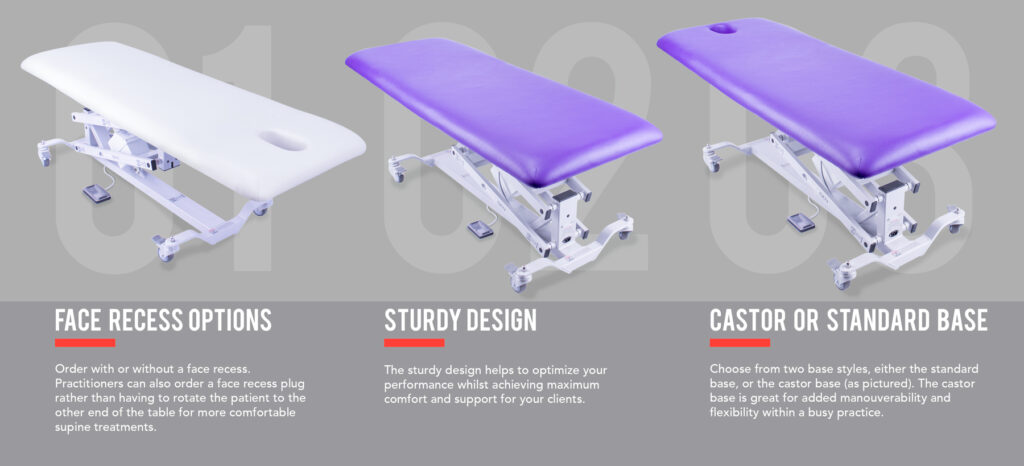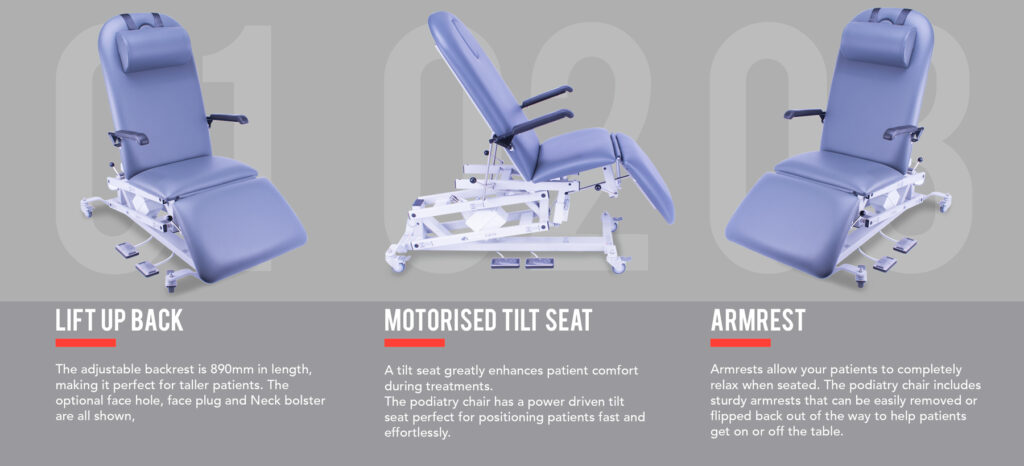Electric Height Adjustment in Modern Physio Practice: The Complete Guide for Australian Practitioners
Electric height adjustment has evolved from a luxury feature to an essential investment for Australian physiotherapy practices, delivering measurable ROI through improved practitioner ergonomics, increased patient throughput, and enhanced clinical outcomes.

Introduction: The Crucial Role of Electric Height Adjustment in Modern Physio Practice
Picture this: it’s 3 PM on a busy Tuesday, and your sixth patient of the day—a 6’4″ rugby player with a lumbar strain—walks into your treatment room. Your previous patient was barely 5’2″ with osteoporosis. Without electric height adjustment, you’d be cranking that manual hydraulic pump 20 times, watching precious appointment minutes tick away while your patient stands there wondering if you’re ready to begin.
This scenario plays out thousands of times daily across physiotherapy practices worldwide, yet many practitioners still tolerate the inefficiency of manual height adjustment. The ripple effects are significant: treatments begin with delays, practitioners develop their own musculoskeletal complaints from poor working postures, and patient throughput suffers measurably.
Electric table features have evolved from luxury additions to essential practice infrastructure. Modern variants provide precise height control within seconds, maintain whisper-quiet operation during patient care, and deliver measurable improvements to both clinical outcomes and business metrics. Understanding these electric table features can transform how you deliver care while protecting your career longevity.
Key Features That Define Professional Electric Treatment Tables
Professional-grade electric treatment tables distinguish themselves through four core electric table features that directly impact daily practice efficiency and patient experience.
Height Adjustability Range and Speed Quality electric systems typically provide 45-60 cm of vertical travel, accommodating practitioners from 5’2″ to 6’6″ in optimal working postures. Professional tables achieve this adjustment in 8-12 seconds maximum—fast enough that patients never feel they’re waiting, yet controlled enough to maintain comfort throughout the movement. The most advanced systems incorporate variable speed controls, allowing rapid movement when unoccupied and gentle adjustment during patient positioning.
200305 Pro-Lift Treatment ABR
Weight Capacity Engineering Commercial-grade electric tables support 125-295 kg safely, engineered with safety factors exceeding 3:1 ratios. This capacity accounts not just for patient weight, but the additional forces generated during manual therapy techniques. Premium systems maintain full functionality across their entire weight range, avoiding the performance degradation common in lower-grade equipment. Popular models like the Pro-Lift Treatment series consistently offer 125 kg capacity, suitable for most clinical applications.
Control Mechanisms and Ergonomics Hand and foot controls provide immediate height adjustment without interrupting patient contact. The most sophisticated systems offer memory preset positions, allowing instant recall of preferred heights for different treatment modalities. Wireless remote controls eliminate the need to locate switches during treatment sessions, while emergency stop functions ensure patient safety during any movement.
Silent Operation Technology German-engineered actuators operate at less than 45 decibels—quieter than normal conversation—ensuring patient relaxation throughout adjustment cycles. This silent operation proves particularly valuable during initial assessments when patient anxiety levels peak, and during treatments requiring sustained relaxation responses.
These foundational electric table features create the platform for enhanced clinical practice, but their true value emerges in the measurable improvements they deliver to practitioner efficiency and patient outcomes.
Real-World Impact: Efficiency Gains and Practitioner Well-being
The transition from manual to electric height adjustment generates documented time savings that compound throughout each practice day. Clinical audits across multiple practices reveal an average of 45 seconds saved per height adjustment—seemingly modest until multiplied across 15-20 daily adjustments per table.
Quantified Time Savings A busy practitioner performing 25 treatments daily saves approximately 18 minutes through electric adjustment alone. This translates to an additional 1.5 appointments weekly, or roughly 75 extra patient visits annually per table. These efficiency gains occur without extending working hours or rushing treatment quality—simply by eliminating manual pump operation.
Patient Throughput Improvements Electric tables enable smoother transitions between patients of varying heights. Reception staff report fewer scheduling constraints when practitioners can accommodate height differences instantly. The psychological impact proves equally valuable—patients perceive practices with electric tables as more professional and technologically current.
Ergonomic Protection for Practitioners Manual table operation requires practitioners to work at suboptimal heights throughout busy days. Research indicates that prolonged work at incorrect table heights contributes to practitioner neck pain, shoulder impingement, and lower back strain. Electric adjustment allows instant optimisation for each treatment technique, reducing these cumulative stress injuries.
Dr. Sarah Chen, who upgraded her two-table practice last year, notes: “I realised I’d been accepting chronic shoulder tension as normal. Within three weeks of electric table installation, that tension disappeared. My energy levels at day’s end improved dramatically.”
Career Longevity Benefits Practitioners using electric tables report reduced physical fatigue and fewer work-related musculoskeletal complaints. Industry surveys suggest that practitioners with electric equipment maintain active practice 3-5 years longer on average, representing significant career earnings preservation.
Patient Comfort and Confidence Electric adjustment eliminates the mechanical sounds and vibrations associated with manual pumping. Patients remain relaxed during height changes rather than tensing in anticipation of jarring movements. This enhanced comfort translates to better treatment outcomes and higher patient satisfaction scores.
These efficiency improvements and ergonomic benefits create a foundation for measurable financial returns that justify electric table investments within predictable timeframes.
Understanding True ROI: Bottom-Line Benefits of Investing in Electric Tables

The financial case for electric treatment tables extends beyond initial purchase price to encompass revenue generation, cost avoidance, and long-term practice sustainability metrics.
Cost Recovery Timeline Analysis Electric table investments typically recover their cost within 8-14 months through increased patient capacity alone. A practitioner seeing one additional patient daily (enabled by time savings) generates $50-75 extra revenue per day, assuming average treatment fees. This compounds to $13,000-20,000 annually per table—often exceeding the equipment’s purchase price within the first year. With quality electric tables ranging from entry-level options to $6,600 for premium systems like the Pro-Lift Apollo 5 Advantage, the return on investment is compelling.
Revenue Enhancement Opportunities Electric tables enable practitioners to accept a broader range of patients without height-related treatment compromises. Practices report 15-20% increases in referrals from elderly patients and those with mobility challenges who specifically request electric table facilities. Sports therapy practices note improved outcomes when treating athletes of varying sizes during the same appointment blocks.
Operational Cost Reductions Manual table maintenance includes hydraulic fluid replacement, pump servicing, and mechanical component repairs. Electric systems eliminate these maintenance categories while requiring only basic motor servicing. Practices report 60-70% reductions in table-related maintenance costs over five-year periods.
Staff Productivity Improvements Reception and support staff spend less time managing appointment scheduling when table height isn’t a constraint. Treatment room turnover improves when assistants don’t need to adjust table heights between patients. These productivity gains accumulate into measurable labour cost savings.
Practitioner Health Cost Avoidance Work-related injury claims and sick day usage decrease substantially when practitioners maintain proper working postures. The average physiotherapy practice pays $3,000-5,500 annually in practitioner sick leave costs related to musculoskeletal complaints. Electric tables reduce these costs by 40-60% according to insurance industry data.
Patient Retention and Premium Positioning Practices with electric tables achieve higher patient retention rates and can command premium pricing for enhanced comfort and professionalism. Market research indicates that patients will pay 8-12% more for treatments delivered on electric equipment, viewing this as evidence of practice quality and investment in patient care.
Long-Term Durability Value Quality electric tables maintain functionality for 15-20 years with basic maintenance, compared to 8-12 years for manual systems requiring regular hydraulic servicing. This extended lifespan provides superior value per year of operation while maintaining consistent performance throughout the equipment’s life.
However, not all electric systems deliver equivalent returns—understanding the technical differentiators between professional and economy-grade equipment proves essential for realising these financial benefits.
Evaluating Electric Adjustment Systems: What Separates Professional Grade from Disappointment
The electric table market spans from budget imports to German-engineered precision systems, with dramatic differences in performance, reliability, and long-term value that aren’t apparent during initial demonstrations.
Actuator Origin and Engineering Standards German-manufactured actuators represent the gold standard for medical equipment applications, engineered to DIN standards exceeding general industrial requirements. These systems undergo 100,000-cycle testing before approval, compared to 10,000-20,000 cycles typical for consumer-grade alternatives. Chinese-manufactured actuators may appear identical superficially but often fail within 2-3 years under clinical usage patterns.
Premium actuators maintain consistent speeds and torque throughout their operational life, while economy versions experience gradual performance degradation. This manifests as slower adjustment speeds, increased noise levels, and eventual position drift that compromises table stability.
Noise Level Engineering Professional electric systems operate below 45 decibels through precision machining and vibration damping. Economy systems often produce 55-65 decibels during operation—loud enough to interrupt patient relaxation and conversation. This noise difference becomes particularly noticeable during longer treatment sessions requiring multiple adjustments.
Speed and Precision Control High-end systems provide variable speed control and soft-start/soft-stop functionality that eliminates jarring movements. Position accuracy within 2-3mm ensures consistent working heights and professional operation. Budget systems often lack speed modulation, creating abrupt starts and stops that disturb patient comfort.
Table Dimensions and Specifications Professional physiotherapy tables typically measure 193-202 cm in length and 75-84 cm in width, providing adequate treatment surface for diverse patient populations. Models like the Pro-Lift Treatment Motorised Back and Pro-Lift Treatment 680 consistently deliver these dimensions alongside 125 kg weight capacity, meeting most clinical requirements effectively.
Making the Right Choice: Practical Selection Criteria
When evaluating electric treatment tables for your practice, consider these factors:
Budget Alignment
- Entry-level electric tables: Starting from $2,982 with models like the Pro-Lift Treatment One suitable for new practices or low-volume settings
- Mid-range systems ($3,400-$4,500): Including the Pro-Lift Treatment ABR at $3,590 and Pro-Lift Treatment 930 at $3,700, ideal for established practices seeking reliability
- Premium models ($4,850-$6,600): Such as the Pro-Lift Access RMS at $4,850 and Pro-Lift Apollo 5 Advantage at $6,600, best for high-volume practices requiring maximum durability

Clinical Requirements
- Standard physiotherapy: Models like the Pro-Lift Treatment ABR with 125 kg capacity typically sufficient
- Sports therapy and chiropractic: Consider specialised models like the Pro-Lift Chiro Basic at $4,400
- Multi-modality practices: Versatile options like the Pro-Lift Access Standard at $3,600 serve physiotherapy, massage, and chiropractic needs
- Osteopathy specialists: Dedicated models including the Pro-Lift Osteo MKII at $4,500 or Pro-Lift Osteo Basic at $3,780

Practice Volume
- 10-15 patients daily: Entry to mid-range systems adequate
- 20+ patients daily: Premium systems justify investment through durability
- Multiple practitioners: Memory presets become essential
Available Models Leading Australian suppliers offer proven systems including:
- Budget-conscious options: Pro-Lift Treatment One from $2,982
- Comprehensive physiotherapy solutions: Pro-Lift Treatment series with multiple configurations
- Speciality practice models: Pro-Lift Podiatry at $4,390 for podiatrists
- Premium multi-modality systems: Pro-Lift Apollo 5 Advantage at $6,600 for high-volume practices
- Medical examination options: Examination Couch Opal at $2,893 for GPs and orthopaedic clinics

Conclusion: Investing in Practice Excellence
Electric height adjustment represents more than equipment upgrade—it’s investment in practice sustainability, practitioner health, and patient experience. The measurable returns through increased efficiency, reduced injury risk, and enhanced patient satisfaction create compelling justification for transitioning from manual systems.
Modern electric tables deliver 45-60 cm of vertical travel within seconds, support 125-295 kg safely, and operate at whisper-quiet levels below 45 decibels. These specifications translate directly into improved clinical outcomes and practice profitability.
For Australian physiotherapy practices, the question isn’t whether to invest in electric tables, but rather which system best aligns with practice needs and growth trajectory. With entry-level systems like the Pro-Lift Treatment One starting at $2,982 and delivering measurable ROI within 8-14 months, electric height adjustment has evolved from luxury to necessity in competitive healthcare markets.
Whether you’re establishing a new practice, upgrading existing equipment, or expanding your treatment capabilities, models ranging from the versatile Pro-Lift Treatment ABR to the premium Pro-Lift Apollo 5 Advantage offer solutions tailored to every practice requirement and budget.
The time saved, injuries prevented, and patient satisfaction gained through electric table investment compound into practice advantages that extend far beyond initial purchase considerations. As healthcare delivery continues evolving toward efficiency and ergonomics, practices equipped with electric height adjustment position themselves for sustained success while protecting their most valuable asset—the practitioners themselves.
